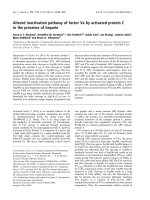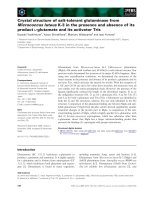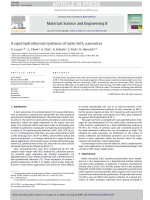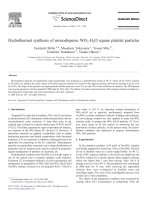- Trang chủ >>
- Khoa Học Tự Nhiên >>
- Vật lý
large-scale hydrothermal synthesis of wo3 nanowires in the presence of k2so4
Bạn đang xem bản rút gọn của tài liệu. Xem và tải ngay bản đầy đủ của tài liệu tại đây (1.8 MB, 5 trang )
Large-scale hydrothermal synthesis of WO
3
nanowires
in the presence of K
2
SO
4
Xu Chun Song
a,
⁎
, Yi Fan Zheng
b
, E. Yang
a
, Yun Wang
a
a
Department of Chemistry, Fujian Normal University, Fuzhou 350007, P.R. China
b
Coll Chem Engn & Mat Sci, Zhejiang University Technol, Hangzhou, Zhejiang 310014, P.R. China
Received 7 July 2006; accepted 21 December 2006
Available online 30 December 2006
Abstract
WO
3
nanowires were fabricated by a hydrothermal method in the presence of K
2
SO
4
. The nanowires exhibit a well crystallized one-
dimensional structure with 10 nm in diameter and several microns in length. Effects of other alkali salts (KNO
3
, NaNO
3
and Na
2
SO
4
) on the
morphologies of WO
3
nanocrystals were also investigated. The important role of K
2
SO
4
salt in the WO
3
nanowires synthesis has been
demonstrated.
© 2006 Elsevier B.V. All rights reserved.
Keywords: Hydrothermal; WO
3
; Nanowires; K
2
SO
4
1. Introduction
Over the past few years, much effort has been devoted to the
synthesis of semiconductor nanowires, nanorods, and nanobelts,
because of the importance of understanding the dimensionality
confined transport phenomena and fabricating nanodevices and
nanosensors [1–4]. Many attempts have been made to synthesize
one-dimensional nanostructured materials [5–14]. Of the meth-
ods used in 1D nanostructure synthesis, hydrothermal processes
have emerged as powerful tools for the fabrication of anisotropic
nanomaterials with some significant advantages, such as
controllable particle size and low-temperature, cost-effective,
and less-complicated techniques. Under hydrothermal conditions,
many starting materials can undergo quite unexpected reactions,
which are often accompanied by the formation of nanoscopic
morphologies that are not accessible by classical routes.
Among various metal oxides, WO
3
is a versatile wide band-
gap semiconductor for many valuable applications. WO
3
has
found useful applications in semiconductor gas devices [15],
electrochromic devices [16], and photocatalyses [17].Thusfar,
preparation of single-crystalline, 1D nanostructured tungsten
oxide in mass quantity has been accomplished by heating a
tungsten foil, covered by SiO
2
plate, in an argon atmosphere at
1600 °C [18] or recently by electrochemically etching a tungsten
tip, followed by heating at 700 °C under argon [19].The
employed harsh conditions, contamination by platelets, and
uncontrolled size hamper systematic investigations on size-
dependent properties of 1D nanostructured tungsten oxide itself
as well as of inorganic derivatives prepared from the oxide.
Recently, the hydrothermal synthesis of ultralong and single-
crystalline Cd(OH)
2
nanowires using alkali salts as mineralizers
was reported by Tang et al. [20]. The 1D nanostructure synthesis
using inorganic salt instead of surfactant and water-soluble high
molecule has strong points in non-pollution, low-cost, easy-
cleanout and recovery. Herein, we describe a facile inorganic
route for synthesis of uniform WO
3
nanowires in aqueous
solution. This novel method is based on treating freshly prepared
H
2
WO
4
in the presence of K
2
SO
4
salt under hydrothermal
conditions at 180 °C for 12 h.
2. Experime ntal
2.1. Synthesis of WO3
Na
2
WO
4
(1 g) was dissolved in 30 ml deionized water to
form a transparent solution. A (3 mol l
− 1
) HCl solution was
added dropwise into the above solution under continuous
Materials Letters 61 (2007) 3904– 3908
www.elsevier.com/locate/matlet
⁎
Corresponding author. Tel.: +86 591 87441126; fax: +86 591 83465376.
E-mail address: (X.C. Song).
0167-577X/$ - see front matter © 2006 Elsevier B.V. All rights reserved.
doi:10.1016/j.matlet.2006.12.055
stirring until tungstenic acid was precipitated thoroughly. Next,
the centrifuged precipitate was dissolved in 30 ml deionized
water, 40 g K
2
SO
4
was added to the system and agitated to form
starchiness, and then transferred into Teflon-lined autoclave
with a capacity of 50 ml. Hydrothermal treatments were carried
out at 180 °C for 12 h. After that, the autoclave was allowed to
cool down naturally. The finally products were collected and
washed with deionized water and ethanol several times and
dried in air at 80 °C. The WO
3
nanowires were finally obtained.
2.2. Characterization
The morphologies were characterized using scanning
electron microscopy (SEM, Hitachi S-4700 II, 25 kV) and
transmission electron microscopy (T EM, JEM200CX, 120 kV).
The composition of the product was analyzed by energy
dispersive X-ray detector (EDX, Thermo Noran VANTAG-ESI,
120 kV). The X-ray diffraction (XRD, Thermo ARL SCINTAG
X'TRA with CuKα irradiation, λ =0.154056 nm) was used to
analyze the crystallinity.
3. Results and discussion
The morphologies of the final products were demonstrated in
Fig. 1a–c. On the basis of the SEM check, the proportion of the
nanowire morphology was estimated to be about 100% (Fig. 1a). As
shown in the SEM images, the average diameter of these uniform
nanowires was about 10 nm and the length was up to several microns
(Fig. 1b). Therefore, the nanowires reached a high aspect ratio of more
than 500. A TEM image of a single nanowire with diameter of about
10 nm was shown in Fig. 1c. The selected area electron diffraction
(SAED) taken from different parts of nanowires indicated that the
sample was single crystalline with a preferential growth in the (001)
direction. The energy dispersive spectrometry (EDS) analysis was
employed to determine the composition of the tungsten oxide
nanowires. As shown in Fig. 2, only oxygen and tungsten elements
existed in the nanowires with molar ratio of about 3 (O/W). A
representative XRD pattern for our synthesized tungsten oxide
nanowire was displayed in Fig. 3. All the main peaks can be indexed
undisputedly to hexagonal WO
3
(JCPDS card 35-1001), which are
consistent with general features of nanomaterials. Diffraction peaks of
Fig. 1. (a) SEM, (b) SEM, (c)TEM images of WO
3
nanowires synthesized at
180 °C for 12 h with 40 g K
2
SO
4
.
Fig. 2. EDS patterns of WO
3
nanowires.
Fig. 3. XRD patterns of WO
3
nanowires.
3905X.C. Song et al. / Materials Letters 61 (2007) 3904–3908
(001) are stronger compared with the rest, indicating that the [001] is
the major growth direction. This agrees well with the SAED results.
The morphologies of synthesized WO
3
with different amounts of
K
2
SO
4
were shown in Fig. 4a–c. Fig. 4a is the TEM image of the
sample obtained without K
2
SO
4
, which has a lamellar structure with
diameter of about 100 nm. With the addition of 15 g K
2
SO
4
, the
morphologies of synthesized WO
3
shown in Fig. 4b are the mixture of
nanorods and nanoparticles. Nanorods and nanowires were obtained
for the products synthesized with 30 g K
2
SO
4
(Fig. 4c). As the content
of K
2
SO
4
reaches 40 g, Fig. 4d shows the TEM image of the solid
sample, where nanowires with lengths around several micrometers and
diameter of about 10 nm are the major product. From the results, it can
be speculated that the content of the assisted K
2
SO
4
plays an important
role in the specific morphologies of WO
3
. No nanowires of WO
3
could
be obtained without K
2
SO
4
, and the purity of the nanowires only
depends strongly on the content of K
2
SO
4
. We have also carried out
synthesis with 40 g K
2
SO
4
at 160 and 200 °C individually. It could be
found that short WO
3
nanorods but generally mixed with nanoparticles
were produced at 160 °C. However, the nanowires were obtained at
200 °C, and the morphology was similar with that obtained at 180 °C.
In addition, we have carried out analogous experiments with
different inorganic salts for comparison. Fig. 5 displayed the TEM
image of the obtained WO
3
with the addition of NaNO
3
, KNO
3
and
Na
2
SO
4
. It can be seen that no WO
3
nanowires could be obtained with
any content of KNO
3
. With an increase in the content of KNO
3
, the
dimension of nanoparticles only became smaller. Similarly, the
nanorods and nanoparticles were obtained in the products with the
addition of NaNO
3
or Na
2
SO
4
. The nanowires of WO
3
were not
obtained at last with any content of KNO
3
and Na
2
SO
4
. It could be
concluded from the results mentioned above that K
2
SO
4
plays an
important role in the synthesis of WO
3
nanowires.
The XRD patterns for WO
3
synthesized with different kinds of
inorganic salts were compared in Fig. 6. It is obvious that the crystalline
phases for WO
3
nanocrystals are discriminatory at different conditions.
The hexagonal phase of WO
3
(JCPDS card 33-1387) was obtained
without salts or in the presence of KNO
3
, NaNO
3
and NaSO
4
(see Fig.
6a–d). Among this, the intensity for the diffraction peaks grew weaker
as follows: no salt N KNO
3
N NaNO
3
N NaSO
4
. On the other hand, Fig.
6e exhibited the hexagonal reflections (JCPDS card 35-1001) in the
presence of K
2
SO
4
. Combined with the TEM results, it could be
concluded that the inorganic salts had a significant effect on the
crystalline phase and the corresponding morphology of WO
3
.
The morphologies and dimensions of synthesized nanocrystals were
controlled not only by the inner structure, but also affected by the
Fig. 4. TEM images of WO
3
synthesized at 180 °C for 12 h with different amounts of K
2
SO
4
: (a) 0 g, (b) 15 g, (c) 30 g, and (d) 40 g.
3906 X.C. Song et al. / Materials Letters 61 (2007) 3904–3908
surrounding conditions such as temperature, pressure, and composition
of the solution [21]. The formations of nanowires first need the
anisotropy during the growth process for the nanoparticles. In our
experiments, the presence of the salts is also an important factor
influencing the crystallization process and the growth of the WO
3
nanowires. With the addition of different inorganic salts, the
compositions and the corresponding properties of the solution are
different in t he hydrothermal conditions. The changes in the
surrounding conditions would affect the crystalline phase, and further
affect the morphologies and dimensions of the WO
3
nanocrystals. As
the reaction mechanism and hydrothermal conditions are complicated,
the exact reason for the 1D nanostructure synthesized in the presence of
inorganic salts needs further investigations.
4. Conclusion
In summary, tungsten o xide nanowires with relatively
uniform diameters ranging from 10 to 20 nm and lengths up
to several micrometers were synthesized on a large scale. With
the distinctive and promising properties of tungsten oxide, the
as-synthesized nanowires may serve as functional materials in
the fabrication of nanosized sensors and flat panel display
systems. The important role of K
2
SO
4
salt in the synthesis has
been demonstrated. This aqueous route should be feasible for
large-scale p roduction of low-dimensional nanostructured
tungsten oxide.
Acknowledgment
We wish to acknowledge the financial support from the
Natural Science Foundation of Fujian Province (no: 2006J0153).
References
[1] D. Wu, J. Liu, X.N. Zhao, A.D. Li, Y.F. Chen, N.B. Ming, Chem. Mater. 18
(2006) 547.
[2] Hao X. Mai, L.D. Sun, Y.W. Zhang, Y. Si, W. Feng, H.P. Zhang, H.C. Liu,
C.H. Yan, J. Phys. Chem., B 109 (2005) 24380.
[3] J.G. Yu, J.C. Yu, W.H. Ho, L. Wu, X.C. Wang, J. Am. Chem. Soc. 126
(2004) 3422.
[4] Y. Xia, P. Yang, Adv. Mater. 15 (2003) 351.
[5] B. Tang, J.C. Ge, C.J. Wu, L.H. Zhuo, Z.Z. Chen, Z.Q. Shi,
Nanotechnology 15 (2004) 1273.
[6] X.F. Duan, Y. Huang, Y. Cui, J.F. Wang, C.M. Lieber, Nature 409 (2001)
66.
[7] X. Peng, L. Manna, W.D. Yang, J. Wickham, E. Scher, A. Kadavanich, A.P.
Alivisatos, Nature 404 (2000) 59.
[8] W.U. Huynh, J.J. Dittmer, A.P. Alivisatos, Science 295 (2002) 2425.
[9] M.J. Hudson, J.W. Peckett, P.J.F. Harris, J. Mater. Chem. 13 (2003) 445.
[10] G. Gu, B. Zheng, W.Q. Han, S. Roth, J. Liu, Nano Lett. 2 (2002) 849.
[11] W.X. Zhang, X.G. Wen, S.H. Yang, Inorg. Chem. 42 (2003) 5005.
[12] J.H. Zhan, Y. Bando, J.Q. Hu, D. Golberg, Inorg. Chem. 43 (2004) 2462.
[13] X.W. Lou, H.C. Zeng, Inorg. Chem. 42 (2003) 6169.
[14] X. Duan, C.M. Lieber, J. Am. Chem. Soc. 122 (2000) 188.
Fig. 5. TEM images of WO
3
nanocrystals synthesized with different salts: (a)
KNO
3
(50 g), (b) NaNO
3
(40 g), (c) Na
2
SO
4
(40 g).
Fig. 6. XRD patterns of WO
3
nanocrystals synthesized with different salts: (a)
no salt, (b) KNO
3
(50 g), (c) NaNO
3
(40 g), (d) Na
2
SO
4
(40 g), (e) K
2
SO
4
(40 g).
3907X.C. Song et al. / Materials Letters 61 (2007) 3904–3908
[15] J.L. Solis, S. Saukko, L. Kish, C.G. Granqvist, V. Lantto, Thin Solid Films
391 (2001) 255.
[16] C. Santato, M. Odziemkowski, M. Ulmann, J. Augustynski, J. Am. Chem.
Soc. 123 (2001) 10639.
[17] K. Sayama, K. Mukasa, R. Abe, Y. Abe, H. Arakawa, Chem. Commun.
(2001) 2416.
[18] Y.Q. Zhu, W. Hu, W.K. Hsu, M. Terrones, N. Grobert, J.P. Hare, H.W.
Kroto, D.R.M. Walton, H. Terrones, Chem. Phys. Lett. 309 (1999) 327.
[19] G. Gu, B. Zheng, W.Q. Han, S. Roth, J. Liu, Nano Lett. 2 (2002) 849.
[20] B. Tang, L.H. Zhuo, J.C. Ge, J. Niu, Z.Q. Shi, Inorg. Chem. 44 (2005)
2568.
[21] X.Y. Zhang, J.Y. Dai, H.C. Ong, N. Wang, H.L.W. Chan, C.L. Choy,
Chem. Phys. Lett. 393 (2004) 17.
3908 X.C. Song et al. / Materials Letters 61 (2007) 3904–3908









